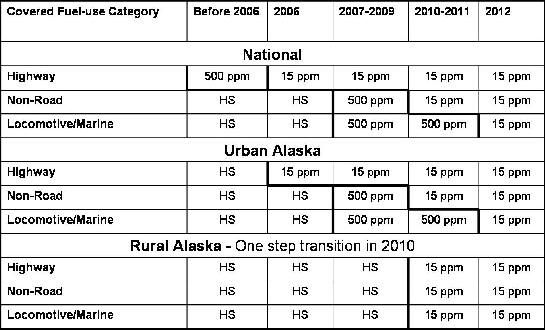Alaska Diesel Strategy - Rule Flexibility
DEC Recommendations on the Federal Diesel Fuel Rules for Rural Alaska
For purposes of making recommendations on the EPA fuel rules, DEC identified areas of Alaska with year round and seasonal fuel distribution.
- Urban Alaska is considered as those areas on the road system connected to the Lower 48 through Canada, or those having regular drive on-drive off ferry service.
- Rural Alaska is considered as those areas off the road and ferry system. It is for these “rural” areas that DEC asked for immediate flexibility in complying with the federal rules.
EPA’s Proposed Rules for Sulfur Levels in Diesel for Rural Alaska
EPA proposed rules for fuel sulfur levels in rural Alaska on October 13, 2005. DEC recommendations were incorporated into the proposed ruling, including the request to accelerate marine sources to the 2010 deadline.
New Source Performance Standards
In July 2005, EPA proposed New Source Performance Standards (NSPS) for stationary diesel internal combustion engines. This rule applies to rural power generators. Like the non-road rule, affected engines were to move to 500 ppm sulfur fuel in 2007 and 15 ppm sulfur fuel in 2010. Also like the non-road rule, DEC recommended EPA allow rural Alaska to skip the 2007 requirement for 500 ppm sulfur diesel and start using 15 ppm sulfur diesel on affected engines in 2010.
Unlike the non-road or on-highway rules, the NSPS does not switch all fuel for these engine types to low or ultra-low sulfur diesel. Only engines considered “new,” “reconstructed,” or “modified” have to use the lower sulfur fuel. "New" engines are newly manufactured engines. An engine is considered "reconstructed" when the cost of replacing worn engine parts equals 50% of the original engine costs. An engine is considered "modified" when any change to the engine causes an increase in air emissions. Given these three criteria, we estimate a full change-over to engines requiring ultra-low sulfur diesel will occur within 15 years.
Link to: DEC comments (PDF). In the final NSPS rule, EPA provided Alaska time to determine an alternative plan to transition rural Alaska public-sector electrical utilities to ULSD.
This process is finished and a final recommendation is available, please see: DEC NSPS Recommendations (PDF)
The Nonroad Rule
DEC’s recommended non-road rule uses 2010 as the conversion date to ULSD. A precedent of 2010 was set with the on-highway rule. 2010 is also the year the federal rule would have non-road fuel transition to ULSD. Therefore, DEC saw no need to ask for a different transition date to ULSD for nonroad sources. DEC did recommend EPA allow rural Alaska to skip a 2007 transition to 500 ppm (known as low sulfur diesel). DEC believes a one step transition to ULSD is preferable to the disruption of a two-step transition. The national non-road rule allows marine sources to move to ULSD in 2012. Out of consideration for a simple one step transition, DEC asked for an acceleration of the transition to ULSD for marine sources from 2012 to 2010. Thus, 2010 remains the bright line date at which conversion to ULSD must occur for all mobile sources, non-road and on-highway.
DEC believes EPA's proposed nonroad rules are a solid solution to the problems of mobile source, and nonroad diesel emissions.
- View DEC's comments (PDF) on EPA's proposed nonroad rule
- View EPA's proposed nonroad rule and supporting information
The On-Highway Rule
DEC recommended a one step transition to 15 ppm (ultra-low sulfur diesel) in summer 2010. This means diesel destined for on-highway mobile sources can remain unregulated until 2010. However, owners of trucks and buses with 2007 and later model year engines must use ultra-low sulfur diesel (ULSD). These users will have ULSD provided to them separate from the established fuel distribution system. In 2010, rural Alaska moves to ULSD for on-highway use with the rest of the nation. At that time, all mobile sources, regardless of model year, must use ULSD. Thus, this plan gives four years for communities to plan for the inevitable transition to ULSD, and four years for the cost per gallon to become more competitive with higher sulfur fuel costs.
The State of Alaska submitted a plan (Press release) to EPA that recommends conversion of "road system" Alaska in the same time frame as the rest of the United States.
On April 1, 2002, DEC submitted a transition plan to EPA for "on-highway" Alaska. Please review the Alaska Transition Plan.
For "rural" Alaska, the state had until June 2003 to review the federal rule's positive and negative effects on rural Alaska and Tribes. See DEC's May 2003 Recommendation for a Transition Plan to Ultra-low Sulfur Diesel (PDF).
View DEC's Final Recommendation (PDF) for a transition plan to ultra-low sulfur diesel in rural Alaska. This recommendation was submitted to EPA by June 13, 2003 as required. We will keep you up to date on EPA's rule making process from this webpage.
Summary Chart - the blocks with "HS" stand for "high sulfur." (Select the chart for a larger, color version)
Thus, 2010 remains the bright line date at which conversion to ULSD must occur for all mobile, non-road and on-highway sources in Alaska. 2010 will also serve as the date where stationary sources will begin their transition to ULSD under the NSPS rules.


 Indicates an external site.
Indicates an external site.